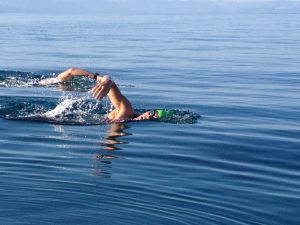Von Collins is an accomplished triathlete and endurance cyclist, and the author of four fitness and training books: Smarter Running, Your First Triathlon Guide, Fit Foods, and 30 Rut-Busting Workouts. He has been cited as a triathlon, cycling, and fitness expert by Healthline, CNET, Forbes, Eat This, Not That and other major outlets.
Swimming in the open water of a triathlon can be challenging, but it can also be a thrill once you gain the confidence, technique, and conditioning to do it well. In addition to the physical challenge, the mental barrier of swimming in open water can be a major factor to deal with. In fact, our unscientific surveys indicate that the open water swim is the main reason people choose not to do triathlons, even when they are very, very close to being able to successfully complete one.
If your swim technique is not where you would like it to be, you might want to break it down and start from the beginning. Getting rid of the bad habits that might have been developed during recreational swimming is a key step to becoming a very fluid, effortless swimmer. Having the right technique can also prevent injury…. and conversely, bad technique can introduce shoulder or back pain that you certainly do not want.
The Swimming Motion

A good swimming motion should be one that is efficient, doesn’t torque your body too much, and is easy on your joints. Most of the best swimmers look like they are not working very hard. They are, no doubt, but for each stroke they are getting much more power, speed, and distance than those with poor form. A swimmer with the right motion has a very level body in the water, reaches their arm forward in a long but comfortable manner, and kicks enough to assist in the motion but not in an inefficient way. They keep their head down, and have a quick and smooth motion when they want to breathe – ideally with the ability to breathe on either side of the body. The stroke is powerful but fluid, and the body has a slight roll from side to side as each stroke is taken.
Pool lap swimmers may also have a great kick-turn that they do, but we advise more triathletes not to get too hung up on that. The fact is that even if you are doing an Ironman, you will never need to do a kick-turn in open water. It is great if you want to learn how to do one, but 99% of triathletes can do very well for a long, long triathlon career without ever doing even a single kick-turn, so don’t sweat it.
Be sure that you eventually get out into the open water as well, assuming your race will be in open water. Open water swimming has a different feel than pool swimming. It is fine to get in shape in a pool, and work on your speed and endurance while doing laps. but sooner or later you should mix in some practice in open water.
Swim Improvement Suggestions
We try to keep everyone updated on ideas for triathlon swim training throughout our site. In addition to the periodic open water swim tips we post here, we thought we would mention the three core things we recommend you consider, in order to to be a more proficient triathlon swimmer.
Total Immersion Swim Training. Retrain yourself to swim correctly using the Total Immersion swim instruction. Total Immersion is the only DVD-or-video-based swim training that we endorse, because we have used it ourselves and seen the benefit first hand. The program breaks down your swim stroke to the basics of motion and balance in the water, and then builds it back up with a technique that you can build on for the rest of your life. Total Immersion also offers open-water-specific instruction. Total Immersion instruction is available from their website with videos, books, or local workshops.
Local Masters Swim Groups. While not necessarily an open water or triathlon focus, masters-level swim groups exist in nearly every large town and metro area. The idea is that a group of swimmers get together regularly with a coach or at least a couple mentors present, and get their pool workout in while trying to also improve their technique. Large health club chains such as Lifetime Fitness offer a number of Masters groups each week, and local Y facilities do as well. Masters groups are great if you are the type of person who thrives in a group setting and likes the idea of a coach to hold you accountable. A small fee is likely required in order to fund the swim lanes as well as the coach, but if you are a member of a fitness club you may want to check with them first, as the price might be substantially less than going somewhere where you are not a member
Local Triathlon/Race Groups. While this one can be a bit hit and miss, many areas of the country have groups or clubs who get together specifically for triathlon or open water swim training. Joining a triathlon club can really help you improve your racing with like-minded people supporting you. These groups can be incredible (if you have access to them) because the comraderie and instruction is geared specifically toward triathletes and open water swimmers. The best place to inquire about these groups is through a local triathlon shop, or through the Race Director of the local races you plan to do. In some cases, Race Directors even host swim “walk-throughs” of the triathlon’s swim course to give people a chance to learn the course prior to race day.
More Resources
Swimming can be a lifelong sport, as evidenced by the octogenarians who often swim in the lanes next to us in the lap pool. We hope that you can make swimming a hobby until very late in life as well. We have developed a few other resources that might be interesting as you work to perfect your triathlon swim technique.
- A beginner’s guide to entry-level wetsuits. Wetsuits are common in most triathlons around the country, save for those in very warm locations or with pool swims. We have developed a guide on how to find the right wetsuit for people who might just be starting out.
- Using a triathlon wetsuit, everything you need to know. This outlines the key steps involved with basic things like putting a wetsuit on, basic care of the wetsuit, and what to expect it to feel like once you start using it.
- Guide to triathlon training plans. Once you have mastered your swim technique, don’t stop. Keep getting faster. We provide our overview of the best triathlon training guides out there, which all include a healthy dose of triathlon swim coaching. Some of these are passive (books) while other plans involve actual hands-on or virtual coaching.
We know that with the right technique and enough good, safe practice in a pool, you can go far in your triathlon “career”. It is all about focus, practice, and being intentional about having the right technique.







